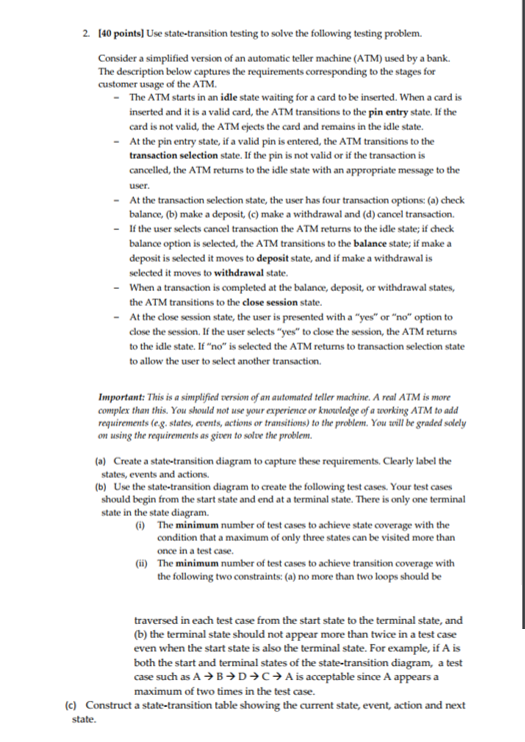
Use state-transition testing to solve the following testing problem Consider a simplified version of an automatic teller machine (ATM) used by a bank The description below captures the requirements corresponding to the stages for customer usage of the ATM. The ATM starts in an idle state waiting for a card to be invited. When a card is inserted and it is a valid card, the ATM transitions to the pin entry state. If the card is not valid, the ATM ejects the card and remains in the idle state. - At the pin entry state, if a valid pin is entered, the ATM transitions to the transaction selection state. If the pin is not valid or if the transaction is cancelled, the ATM returns to the idle state with an appropriate message to the user. - At the transaction selection state, the user has four transaction options: (a) check balance, (b) make a deposit (c) make a withdrawal and (d) cancel transaction. - If the user selects cancer transaction the ATM returns to the idle state: if check balance option is selected, the ATM transitions to the balance state: if make a deposit is selected it moves to deposit state, and if make a withdrawal is selected it moves to withdrawal state. - When a transaction is completed at the balance, deposit, or withdrawal stales, the ATM transitions to the close session state. - At the close session state, the user is presented with a "yes" or "no" option to dose the session. If the user selects "yes" to close the session, the ATM returns to the idle state. If "no" is selected the ATM returns to transaction selection state to allow the user to select another transaction. Important: This is a simplified version of an it automated teller machine. A real ATM is more complex than this. You should not use your experience or knowledge of a working ATM to add requirements (e.g. states, events, actions or transitions) to the problem You will be graded solely on using the requirements as given to solve the problem (a) Create a state-transition diagram to capture these requirements. Clearly label the states, events and actions. (b) Use the state-transition diagram to create the following test cases. Your test cases should begin from the start state and end at a terminal state. There is only one terminal state in the slate diagram. (i) The minimum number of test cases to achieve state coverage with the condition that a maximum of only three states can be visited more than once in a test case. (ii) The minimum number of test cases to achieve transition coverage with the following two constraints: (a) no more than two loops should be traversed in each test case from the start state to the terminal state, and (b) the terminal state should not appear more than twice in a test case even when the start state is also the terminal state. For example, if A is both the start and terminal states of the state-transition diagram, a test case such as A rightarrow B rightarrow D rightarrow C rightarrow A is acceptable since A appears a maximum of two times in the test case. (c) Construct a state-transition table showing the current state, event action and next state







